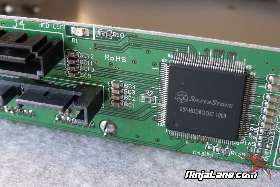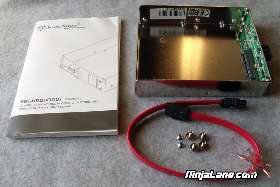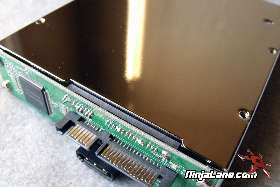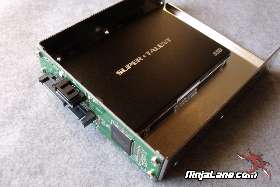After careful consideration I have decided to transfer all hardware review activities to a new domain. I purchased Hardwareasylum.com in 2012 and have been working hard to build a new and improved Ninjalane on that domain. If you are reading this you have reached one of the archived articles, news, projects and/or reviews that were left behind during the site migration.
Please update your bookmarks and be sure to visit the new and improved Ninjalane at Hardwareasylum.com
SilverStone HDDBoost Review
Author: Jim Manis
Published: Sunday, August 22, 2010
A Closer Look
Installation is not unlike adding an additional drive or your system. There are no changes that need to be made in BIOS (in most cases). Simply install an empty formatted SSD into the HDDBoost and connect the supplied cable to your existing HDD. The cable that was originally connected your HDD will now connect to the HDDBoost.
The SilverStone HDDBoost mounts in any Standard 3.5" HDD bay and will work with just about any drive cage arrangement. It does not appear to be compatible with HOT SWAP bays, so be sure to check the various alignments before installation.
Once mounted, the last thing to verify is that the HDDBoost can be seen by the BIOS and selected as a bootable drive. From this point forward the 2 separate drives will not act as independent disks but rather as a single device with a name of HDDBoost.
The SilverStone HDDBoost mounts in any Standard 3.5" HDD bay and will work with just about any drive cage arrangement. It does not appear to be compatible with HOT SWAP bays, so be sure to check the various alignments before installation.
Once mounted, the last thing to verify is that the HDDBoost can be seen by the BIOS and selected as a bootable drive. From this point forward the 2 separate drives will not act as independent disks but rather as a single device with a name of HDDBoost.
The HDDBoost's integrated circuits handle every read/write command sent to the drives; this allows the microprocessor to direct the flow of data to the drive that is best suited for it. The downside of this is the additional overhead present on all operations.
Spindle drives have been the standard in storage for many years and the weaknesses of their design have been fortified over those years by adding larger caches and denser platters. These have helped increase both efficiency and speed. The inherent problem of a rotational drive is the speed of read and write operations near the hub of the platter where speed drops off dramatically. And of course noise power and heat are considerations for many.
Standard HDDs have still have a major advantage in cost per GB and that looks to be the story for a while until SSDs can be made much more cost effective.
Spindle drives have been the standard in storage for many years and the weaknesses of their design have been fortified over those years by adding larger caches and denser platters. These have helped increase both efficiency and speed. The inherent problem of a rotational drive is the speed of read and write operations near the hub of the platter where speed drops off dramatically. And of course noise power and heat are considerations for many.
Standard HDDs have still have a major advantage in cost per GB and that looks to be the story for a while until SSDs can be made much more cost effective.
The device is clearly a no nonsense design but they did at least use a nice finish on the metal and the layout is very clean. There are also LEDs on the circuit board to indicate disk access and that the unit has power.





